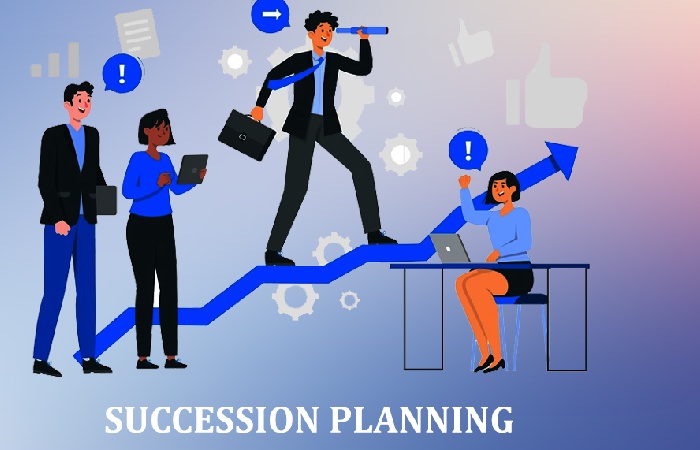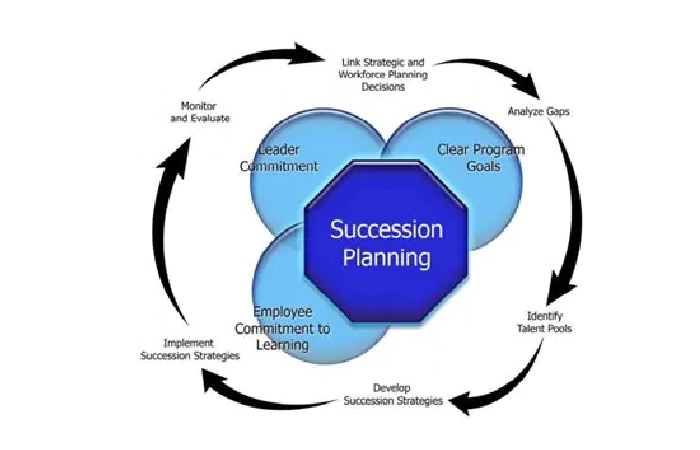Succession planning is a strategic process that seeks to anticipate changes in leadership positions within a company or organization, identifying and developing employees to fill those key roles. This is where an effective succession plan becomes very relevant.
Its goal is to prepare potential candidates by developing the skills and knowledge necessary to assume leadership responsibilities in the future.
Succession planning is critical to an organization’s success as it ensures continuity in leadership, decreases the risks associated with leadership changes, and supports business growth and sustainability.
What is succession planning?

Succession planning refers to a strategic process by which a company internally identifies and develops its people to fill critical organizational positions.
They aim to ensure a smooth leadership transition when new resource requirements arise. It involves assessing the skills and abilities of employees and preparing them to obtain future responsibilities.
By doing so, organizations can fill critical positions with qualified candidates already familiar with the company’s culture, values, and goals.
Succession planning has several objectives. First, it seeks to develop an internal talent pool to fill critical positions, reducing reliance on external recruitment.
In addition, it seeks to identify employees with the potential to assume leadership roles and expand their skills and abilities to prepare them for more future opportunities.
By fostering the development of internal talent, organizations can reduce the costs associated with external recruiting, such as advertising, interviewing, and training expenses.
Additionally, internal candidates already understand the organization’s culture, processes, and values, which can facilitate a faster transition and more effective leadership.
Why is a practical succession plan key in your business?

Implementing a succession plan is critical to your business for several reasons.
- First, it helps you identify and develop an internal talent map, ensuring you have trained employees ready to fill critical positions in your organization. It allows you to quickly find the right person to fill vacancies in the short, medium, and long term.
- Unlike traditional approaches, current succession plans have evolved to accommodate flatter organizational structures.
- A shortage of specific profiles in the labor market, and competition for the most qualified talent with the most significant potential.
- These new approaches build on broader, more strategic strategies, unlocking the potential of employees, teams, and the organization.
- In addition, they are carried out openly, with a focus on diversity, and are aligned with other global talent management policies.
- Implementing a current succession plan offers several benefits for your business. First, it reduces risk by protecting yourself from sudden and unexpected changes.
- It also helps you identify vulnerabilities and significant gaps in skills and competencies. In addition, it promotes employee training and development opportunities, facilitating knowledge transfer within the organization.
- Lastly, it contributes to talent retention, reducing the costs associated with staff turnover.
With all these benefits in mind, implementing a succession plan is a valuable process worth investing time and resources in to ensure the continuity and success of your business.
Who is involved in the development and implementation of a succession plan?

Designing and implementing an effective succession plan requires close collaboration between the Human Resources department and the organization’s directors and managers.
Its joint approach is ultimately aimed at achieving a clearly defined goal. Since the succession plan is focused on the future, it must align with the vision and strategic objectives of the business.
In addition, the succession plan must be consistently integrated with other broader human resource strategies, such as workforce planning, training and development, and compensation.
As for the directors and managers, they are assigned the following responsibilities:
- Have a deep understanding of the company’s operating environment and understand how the market tends to change.
- Have a solid understanding of business strategy and the skills and competencies needed for the future.
- Be well-informed about the context of the labor market and present and future roles.
- Focus on the current and future needs of the organization’s skills and abilities.
- Be aware of possible social changes that may impact future skills and the availability of people with those skills.
As for Human Resources, its role is essential and covers:
- Design and manage evaluations to identify and evaluate internal talent.
- Administer and maintain employee data, guaranteeing accuracy and confidentiality.
- Develop and maintain software systems and databases that facilitate the management of the succession plan.
- Provide advice and guidance in evaluating employees, helping to identify strengths and areas of development.
- Providing support in individual development needs, including training opportunities and professional growth.
- Collaboration between Human Resources and the organization’s directors and managers is essential to implement an effective succession plan.
- It implies proper management of evaluations, accurate data management, technological tools, and providing individualized support to employees in their professional development.
Creating a succession plan step by step

Establish a long-term strategy
- It is essential to define and analyze the long-term strategy of your business, considering market trends, changes in the ways of working, and current equality and diversity policies.
- Instead of focusing solely on current needs, thinking about what your business will require in the future is essential. Conducting strategic analysis lays the foundation for the next step in the succession planning process.
Develop a talent framework
- Today’s talent frameworks are crucial competencies or behaviors critical to an organization’s success. These frameworks must be aligned with the strategy and the present and future needs of the business.
- Modern talent frameworks typically include transversal competencies related to leadership, change and uncertainty management, and digital competencies.
- Aligned with your business strategy, Its framework provides a fair and equitable way to describe talent and potential within your organization.
- In addition, it will set clear performance expectations and serve as a standard reference framework for evaluating performance.
Identify critical positions
- At This stage, defining which positions are considered key for your company is necessary.
- It implies taking into account factors such as the position’s impact on the business’s development.
- The difficulty in finding specific profiles in the labor market, and the cost of training necessary to prepare someone for that position.
- Once you have established the criteria, select the positions that meet those characteristics and add them to your succession plan.
Define the competencies of critical positions
- Once you have selected the works in the organization to be included in the succession plan, it is essential to define the requirements necessary to perform the responsibilities of those positions successfully.
- It includes considering the education level, languages, work experience, technical skills, and competencies that will ensure adequate performance.
- Digital skills and the ability to manage changing and complex situations have become essential to success.
- In addition, we are increasingly faced with new roles in the labor market that require innovative skills and knowledge that have not yet been incorporated into the traditional educational programs of universities and business schools.
Conduct talent mapping and identify potential
Once you have defined the key positions and the competencies necessary for successful performance, it is time to remember the talent available in your organization in the short, medium, and long term.
It involves creating a talent map that will allow you to identify people with the necessary potential to occupy the positions included in the succession plan and define the actions required to support potential successors in their trajectory.
To achieve It, you must implement evaluation processes that ensure objective identification of high-potential candidates, minimizing the biases inherent in more traditional succession planning approaches.
These assessments typically last from half a day to two days, during which participants are assessed using various techniques, such as:
- Psychometric evaluations: Personality, agility, and motivation questionnaires are used.
- Individual or group simulation exercises: Participants face business situations outside their comfort zone to assess their skills.
- Such as analysis, presentation, decision-making activities, role play, data research exercise, or in-tray evaluation.
- Competence-based interviews are conducted to deepen the evaluated professionals’ trajectory, achievements, and motivations.
It is essential to consider that, for certain positions, a specific profile requires, and other aspects such as availability for geographical mobility or travel, must evaluate together with the participant.
The “Succession Pool” must comprise people who can develop the necessary skills for key positions in the short or medium term and whose investment in development and retention generates a favorable return.
Develop the talent
Once the people with potential who will be part of the succession plan have been identified, it is time to develop their skills and competencies.
To do It, you must create individual and group development plans, considering the turnover risk associated with each position. The goal is to focus resources on developing key places that could become vacant due to retirement and brain drain, among other factors.
Unlike traditional succession approaches that relied on internal promotion chains, today’s succession planning allows people to develop in a variety of ways, such as:
- Horizontal or vertical moves into new roles.
- Participation in transversal projects that provide them with diverse experience.
- Opportunities to gain international experience, significant in companies with a global presence.
- Access to training and development programs tailored to your needs.
- Support from mentors or coaches, either in person or remotely, to strengthen their skills and develop agility and resilience.
- Coaching programs are among the most common development programs align with current trends and the socioeconomic context.
- Unlike in the past, where these programs were primarily aims at high-level executives.
- In recent years, they have proven effective in developing competencies and skills at various levels of the organization.
- Therefore, they have increasingly introduce into development programs for a wider variety of profiles within the business.
Communication of the succession plan
- When implementing a succession plan, it is important to consider communication of the process.
- First, you must decide if you want the process to be public or not, even for the people involved.
- If you decide to communicate it, you must determine who within the organization should inform.
- How you want to share it, and what channels you will use to transmit the information.
- Since more and more professionals value an employer’s development opportunities.
- When choosing a project, many companies choose to make their Talent Programs public.
- In these cases, it is crucial to establish the game’s rules to avoid creating false expectations.
- In addition, it is essential to apply the defined promotion and succession policies to develop a solid model and build trust in the teams.
- Employee expectations with established succession policies and practices.
- Transparent and effective communication of the succession plan will help employees understand opportunities for growth and development within the organization.
- It will promote an environment of trust and motivation, aligning





